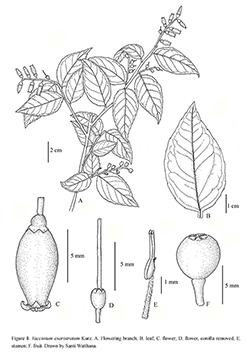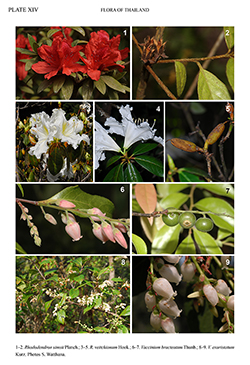e-Flora of Thailand
Volume 13 > Part 1 > Year 2015 > Page 137 > Ericaceae > Vaccinium
5. Vaccinium exaristatum Kurzwfo-0001048496
J. Asiat. Soc. Bengal, Pt. 2, Nat. Hist. 42(2): 86. 1873; Forest Fl. Burm. 2: 91. 1877; Dop, Fl. Indo-Chine [P.H. Lecomte et al.] 3: 711. 1930; H.R.Fletcher, Fl. Siam. 2: 312. 1938; S.H.Huang & R.C.Fang, Fl. Yunnan. 5: 335. 1991; R.C.Fang & P.F.Stevens, Fl. China 14: 493. 2005. Fig. 8; Plate XIV: 8–9.
Accepted Name : This is currently accepted.
Synonyms & Citations :
Description : Shrub or small tree to 8 m tall; young branches glabrous to pubescent; young leaves reddish orange. Leaves spiral, variable in shape and size, ovate, oblanceolate or elliptic, (2.5–)4–7(–10) by 1.5–4 cm; chartaceous to coriaceous; base rounded; margin serrulate and subrevolute; apex acuminate; midrib subprominent above, glabrous or hairy at the base, prominent beneath; veins 6–9 on each side of midrib; petiole 2–3 by ca 1.5 mm, densely hairy to glabrous. Inflorescences terminal or subterminal racemes, 3–5 cm long; peduncle and pedicel glabrous to pubescent. Flowers white or pinkish white; floral bracts narrowly triangular, acute, 2–4 mm long, deciduous or rarely subpersistent; pedicels 2–5 mm long, glabrous to hairy, articulate; bracteoles triangular, 1–3 mm long, deciduous. Calyx tube cup-shaped, glabrous to hairy, 1–1.5 by 1.5–2.5 mm, slightly 5-angled; calyx limbs connate at the base, triangular, 1 by 1.5 mm, glabrous to hairy, entire to fimbriate, acute to acuminate. Corolla urceolate or suburceolate, 5–9 by 3–5 mm, slightly 5-angled; lobes ca 1 mm long, expanded, glabrous on both surfaces or slightly hairy outside. Stamens 8–10; filaments 2–3 mm long, narrowing towards the apex, densely hairy especially at the base; anthers 0.8–1 mm long; tubules 1.8–2 mm long, with or without spurs. Disc glabrous or with brown hairs. Styles 5–7 mm long, glabrous; stigma truncate. Fruits globose, 5–6 mm in diam., glabrous or slightly hairy; stalk 2–6 mm long. Seeds ovoid to ellipsoid, angular, 1–2 by 0.8–1 mm.
Thailand : NORTHERN: Mae Hong Son (Mae Lanoi, Khun Yuam), Chiang Mai (Doi Suthep-Pui, Doi Inthanon, Doi Chiang Dao, Mae Taeng, Mae Rim, Doi Lang Ka, Doi Chang, Angkhang, Om Koi, Mae Sanam, Hod, Doi Saket, San Kampaeng), Chiang Rai (Doi Tung, Doi Luang, Mueang District), Nan (Doi Phu Kha), Lampang (Doi Khun Tan), Sukhothai (Khirimat), Phitsanulok (Phu Miang); NORTH-EASTERN: Phetchabun (Nam Nao), Loei (Phu Ruea), Khon Kaen (Dong Lan); SOUTH-WESTERN: Kanchanaburi (Khao Rai Yai).
Distribution : China, Myanmar (type), Indochina.
Ecology : In dry dipterocarp, pine-dipterocarp and montane forests, 900–2,500 m alt. Flowering: December–April; fruiting: February–May.
Vernacular : Som pi (ส้มปี้), som pae (ส้มแปะ)(Northern); mao hin (เม้าหิน), som saet (ส้มแสด), hua waen (หัวแหวน).


